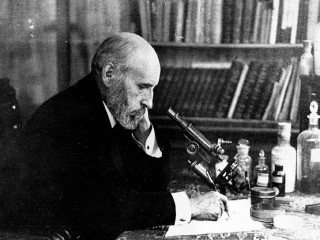
Santiago Ramon Y Cajal biography
Date of birth : 1852-05-01
Date of death : 1934-10-17
Birthplace : Petilla, Spain
Nationality : Spanish
Category : Science and Technology
Last modified : 2011-12-17
Credited as : scientist, the father of modern neuroscience, Nobel laureate
6 votes so far
Ramón y Cajal's early work was accomplished at the Universities of Zaragoza and Valencia, where he focused on the pathology of inflammation, the microbiology of cholera, and the structure of epithelial cells and tissues. It was not until he moved to the University of Barcelona in 1887 that he learned Golgi's silver nitrate preparation and turned his attention to the central nervous system. During this period he made extensive studies of neural material covering many species and most major regions of the brain.
Ramón y Cajal made several major contributions to neuroanatomy. He discovered the axonal growth cone, and provided the definitive evidence for what would later be known as "neuron theory", experimentally demonstrating that the relationship between nerve cells was not one of continuity, but rather of contiguity. "Neuron theory" stands as the foundation of modern neuroscience.
He provided detailed descriptions of cell types associated with neural structures, and produced excellent depictions of structures and their connectivity.
He was an advocate of the existence of spines, although he did not recognize them as the site of contact from presynaptic cells. He was a proponent of polarization of nerve cell function and his student Lorente de No would continue this study of input/output systems into cable theory and some of the earliest circuit analysis of neural structures.
In the debate of the neural network theories (neuron theory, reticular theory) Ramón y Cajal was a fierce defender of the neuron theory.
He discovered a new type of cell, to be named after him: the interstitial cell of Cajal (ICC).This is not neural or glial, but a cell that is something in between, vitally mediating neurotransmission from nerves to bowel smooth muscle cells.
In his 1894 Croonian Lecture, he suggested in an extended metaphor that cortical pyramidal cells may become more elaborate with time, as a tree grows and extends its branches. He also devoted a considerable amount of his time to studying hypnosis (which he used to help his wife with birth labor) and parapsychological phenomena, but a book he had written on these areas got lost during the Spanish Civil War.
[edit] Distinctions and books
Among his many distinctions and societal memberships, Ramón y Cajal was also made an honorary Doctor of Medicine of the Universities of Cambridge and Würzburg and honorary Doctor of Philosophy of the Clark University.
He published over 100 scientific works and articles in French, Spanish, and German. Among his most notable were Rules and advices on scientific investigation, Histology, Degeneration and regeneration of the nervous system, Manual of normal histology and micrographic technique, Elements of histology, Manual of general Anatomic Pathology, New ideas on the fine anatomy of the nerve centres, Textbook on the nervous system of man and the vertebrates, and The retina of vertebrates.
In 1905, he published five science-fictional "Vacation Stories" under the pen name "Dr. Bacteria." In 1906 he was awarded the Nobel Prize in Physiology or Medicine together with an Italian man of science, Golgi 'in recognition of their work on the structure of the nervous system'. This was seen as quite controversial owing to the fact Golgi, a stout reticularist, disagreed with Cajal in his view of the neurone doctrine.
Author of books:
-Manual of normal histology and micrographic technique (1889, textbook)
-New ideas on the fine anatomy of the nerve centres (1894, textbook)
-The retina of vertebrates (1894, textbook)
-Manual of General Pathologic Anatomy (1896, textbook)
-Texture of the nervous system of man and the vertebrates (1897, textbook)
-Advice for a Young Investigator (1901, autobiography)
-Histology of the Nervous System (1904, textbook)
-Holiday tales (1905, science fiction stories, pen name Dr. Bacteria)
-Photograph of colours (1912, textbook)
-Studies on the Degeneration and Regeneration of the Nervous System (1913, textbook)
-Café Conversations (1921, memoirs)
-The World from an Eighty-Year-Old's Point of View (1934, memoirs)
















